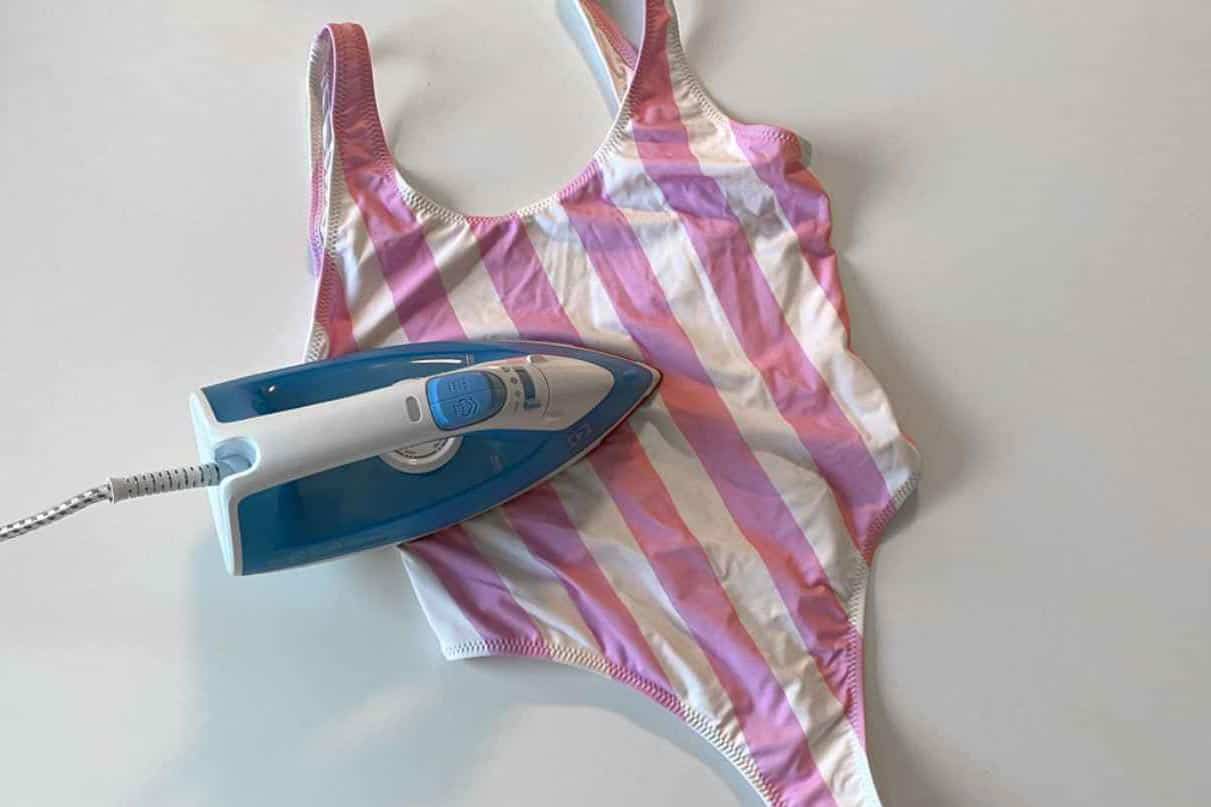Home>How-to Guides>For Women>How To Fix Faded Swimsuit


For Women
How To Fix Faded Swimsuit
Modified: July 30, 2023
Discover how to fix faded swimsuits for women with these easy tips and tricks. Revitalize your favorite swimwear and enjoy vibrant colors all summer long!
(Many of the links in this article redirect to a specific reviewed product. Your purchase of these products through affiliate links helps to generate commission for Under-tec.com, at no extra cost. Learn more)
Table of Contents
Introduction
Swimsuits are more than just clothing; they are a symbol of confidence and style. However, after multiple uses and exposure to sun, chlorine, and saltwater, they can start to lose their vibrant color and fade over time. If you find yourself with a faded swimsuit, don’t worry – there are steps you can take to bring it back to life.
A faded swimsuit can be disappointing, especially if it’s one of your favorite pieces. But before you give up on it, it’s important to understand the causes of fading and explore options for fixing it. From exposure to harsh chemicals to repeated washing, several factors can contribute to the fading of your swimsuit’s color.
In this article, we will delve into the causes of faded swimsuits, how to assess the damage, and the steps to fix them. Whether you have a faded bikini, one-piece, or tankini, we will guide you through the process of restoring its original color and vitality.
It’s worth mentioning that the methods we will discuss are primarily applicable to swimsuits made of fabric blends like nylon, spandex, and polyester. If you have a swimsuit made of special materials like neoprene or other proprietary fabrics, it’s recommended to consult the manufacturer’s instructions or seek professional assistance.
So, if you’re ready to revive your faded swimsuit and get it ready for your next beach getaway, dive in as we explore the steps to fix a faded swimsuit and bring it back to life.
Understanding the causes of faded swimsuits
Before diving into the process of fixing a faded swimsuit, it’s important to understand what causes the fading in the first place. By knowing the factors that contribute to the loss of color, you can take preventive measures to prolong the lifespan of your swimsuit.
One of the primary causes of faded swimsuits is exposure to the sun’s ultraviolet (UV) rays. Over time, these rays can gradually break down the dye molecules in the fabric, resulting in color fading. This is especially true if you frequently spend long hours under the scorching sun without proper protection.
Chlorine is another culprit behind faded swimsuits. Pools are commonly treated with chlorine to kill off bacteria and other contaminants, but this chemical can have a bleaching effect on fabrics. The more you expose your swimsuit to chlorinated water, the higher the chances of color fading.
Saltwater is another factor that can contribute to color loss in swimsuits. The high sodium content in seawater, combined with the abrasive action of sand and waves, can accelerate color fading. Therefore, if you frequently swim in the ocean, it’s important to rinse your swimsuit with fresh water after each use to remove any residual salt.
Repeated washing and improper care can also lead to faded swimsuits. Aggressive washing techniques, such as using harsh detergents or scrubbing vigorously, can cause the dye to fade and weaken the fabric. Additionally, not properly drying your swimsuit after each use can result in mold or mildew growth, which can further deteriorate the color and quality of the fabric over time.
Furthermore, certain fabrics are more prone to fading than others. Swimsuits made of synthetic materials like nylon, spandex, and polyester are known for their colorfastness and ability to resist fading. However, even these fabrics can experience color loss under extreme conditions.
By understanding these causes, you can take steps to minimize the fading of your swimsuit and ensure its longevity. In the next section, we will discuss how to assess the damage to your swimsuit and determine the best course of action to fix it.
Assessing the damage to your swimsuit
Before you proceed with fixing your faded swimsuit, it’s essential to assess the level of damage to determine the appropriate approach for restoration. Here are some steps to help you evaluate the condition of your swimsuit:
1. Examine the overall color: Take a close look at the entire swimsuit and determine how much color fading has occurred. Is the fading uniform across the entire piece or concentrated in specific areas? This assessment will help you decide whether you need to restore the entire swimsuit or focus on targeted areas.
2. Check for fabric integrity: Inspect the fabric for any signs of wear or damage, such as pilling, thinning, or stretched-out elastic. If the fabric is significantly weakened, it may not be worth the effort to restore the swimsuit, as additional stress may cause it to deteriorate further. Consider the overall quality and condition of the swimsuit before proceeding with any restoration techniques.
3. Evaluate the impact on patterns and designs: If your swimsuit has intricate patterns, prints, or designs, assess how the fading has affected them. Determine whether the patterns have become dull or faded, as this may require additional steps to restore their vibrant appearance.
4. Consider the age of the swimsuit: Keep in mind that older swimsuits may be more prone to fading and may not regain their original color as effectively as newer ones. Swimsuits that have been used for several seasons may have endured more wear and tear, making color restoration more challenging.
Once you have assessed the damage and considered these factors, you will have a better understanding of the condition of your swimsuit and can proceed with the appropriate restoration techniques. In the next section, we will discuss how to prepare your swimsuit before applying any fixative measures.
Preparing your swimsuit for fixing
Before you begin the process of fixing your faded swimsuit, it’s essential to properly prepare it to ensure the best results. Follow these steps to prepare your swimsuit for restoration:
1. Wash the swimsuit: Start by thoroughly washing your swimsuit to remove any dirt, salt, chlorine, or other substances that may be on the fabric. Use a mild detergent specifically designed for delicate fabrics and hand-wash the swimsuit gently. Avoid using harsh chemicals or bleach, as these can further damage the fabric.
2. Rinse thoroughly: After washing, rinse your swimsuit with cool water to remove any residual soap or detergent. Make sure to rinse both the front and back of the swimsuit to ensure a thorough cleaning.
3. Gently squeeze out excess water: Carefully squeeze the swimsuit to remove excess water. Avoid wringing or twisting the fabric, as this can stretch or deform the swimsuit. Instead, press the swimsuit gently between your palms to remove as much water as possible.
4. Lay it flat to dry: Place your swimsuit on a clean towel or drying rack, making sure to shape it back into its original form. Avoid hanging it, as this can cause the weight of the water to stretch the fabric. Allow the swimsuit to air dry completely before proceeding with any restoration techniques.
5. Protect the surrounding area: If you choose to use fabric dye or paint to restore the color, it’s important to protect the area in which you’ll be working. Lay down a plastic sheet or old newspaper to prevent any spills or drips from staining your work surface.
By properly preparing your swimsuit, you create the ideal foundation for the restoration process. The next section will delve into the steps involved in using fabric dye to restore the color of your faded swimsuit.
Using fabric dye to restore color
If your swimsuit has experienced significant color fading and you want to restore its vibrancy, using fabric dye can be an effective solution. Here’s a step-by-step guide on how to use fabric dye to restore the color of your faded swimsuit:
1. Choose the right fabric dye: Ensure that you select a fabric dye that is suitable for your swimsuit’s material. Look for a dye specifically formulated for synthetic fabrics like nylon, spandex, or polyester. Read the product label carefully to ensure it is safe to use on swimwear.
2. Gather the necessary materials: In addition to the fabric dye, gather other essential materials such as gloves, a plastic container or stainless steel sink, hot water, and a stirring stick. Make sure to protect your work area with a plastic sheet or old newspaper to avoid staining any surfaces.
3. Mix the dye and hot water: Follow the instructions on the fabric dye packaging to prepare the dye bath. Typically, this involves dissolving the dye powder in hot water. Use the recommended temperature stated on the packaging, as different dyes may have varying temperature requirements.
4. Submerge the swimsuit: Once the dye bath is prepared, carefully submerge your washed and dried swimsuit into the dye bath. Stir the swimsuit gently using the stirring stick to ensure even color distribution. Keep in mind that the longer you leave the swimsuit in the dye bath, the darker the color will be.
5. Rinse and dry the swimsuit: After the desired color is achieved, carefully remove the swimsuit from the dye bath and rinse it thoroughly with cool water. Gradually increase the water temperature during rinsing to ensure that excess dye is completely removed. Once rinsed, squeeze out the excess water and lay the swimsuit flat to dry.
It’s important to note that the effectiveness of fabric dye may vary depending on the fabric, the previous color of the swimsuit, and the dye brand used. Additionally, some fading may not be completely reversible. Ensure that you carefully follow the instructions provided with the fabric dye for the best results.
In the next section, we will explore an alternative method using fabric paint to fix faded areas on your swimsuit.
Applying fabric paint to faded areas
If the fading on your swimsuit is localized to specific areas, such as patterns or designs, using fabric paint can be an effective way to restore those areas to their original color. Follow these steps to apply fabric paint to faded areas on your swimsuit:
1. Select the appropriate fabric paint: Choose a fabric paint that is suitable for your swimsuit’s material and color. Look for a paint specifically designed for use on synthetic fabrics like nylon, spandex, or polyester. Ensure that the paint color matches or is similar to the original color of the faded areas.
2. Prepare the swimsuit: Before applying fabric paint, make sure your swimsuit is clean and dry. Wash and rinse the swimsuit following the recommended steps mentioned earlier. Ensure that the faded areas are free from any dirt, salt, or chlorine residue.
3. Protect surrounding areas: Cover any unaffected areas of the swimsuit with painter’s tape or plastic wrap to prevent accidental paint splatters. This will ensure that only the faded areas receive the fabric paint and that the rest of the swimsuit remains untouched.
4. Apply the fabric paint: Squeeze a small amount of fabric paint onto a palette or disposable dish. Using a fine-tipped paintbrush or a fabric paint pen, carefully apply the paint onto the faded areas of the swimsuit. Start with thin layers and build up the color gradually, allowing each layer to dry before applying the next one.
5. Allow the paint to dry and set: Once you have applied the fabric paint, let the swimsuit dry completely. Follow the instructions on the fabric paint packaging to determine the recommended drying time. After the paint has dried, it’s advisable to heat-set it using an iron or by placing the swimsuit in a dryer according to the manufacturer’s instructions.
Keep in mind that fabric paint may not provide an exact color match, especially if the original fading is extensive. Additionally, it’s important to test the fabric paint on a small, inconspicuous area of the swimsuit first to ensure that it adheres well and does not cause any unwanted reactions.
By following these steps, you can effectively restore the faded areas of your swimsuit using fabric paint. In the next section, we will discuss preventive measures to help prolong the color vibrancy and lifespan of your swimsuit.
Preventing further fading of your swimsuit
Once you have successfully restored the color of your faded swimsuit, it’s important to take preventive measures to avoid further fading and maintain its vibrancy over time. Here are some tips to help you prevent the fading of your swimsuit:
1. Rinse after each use: After swimming in the pool or ocean, rinse your swimsuit with fresh water. This will help remove chlorine, salt, and other chemicals that can accelerate fading. Simply rinse the swimsuit under a faucet or shower, making sure to thoroughly rinse both the front and back.
2. Hand-wash with gentle detergent: Avoid machine-washing your swimsuit, as this can cause unnecessary friction and wear. Instead, hand-wash your swimsuit using a mild detergent specifically formulated for delicate fabrics. Gently agitate the swimsuit in a basin or sink, then rinse thoroughly with cool water.
3. Avoid excessive wringing or twisting: When squeezing out excess water from your swimsuit, avoid wringing or twisting the fabric. This can stretch or deform the swimsuit, compromising its color and shape. Instead, gently press the swimsuit between your palms to remove the water.
4. Dry in the shade: Direct sunlight can be harsh on fabrics and contribute to color fading. After rinsing, lay your swimsuit flat in a well-ventilated area away from direct sunlight to dry. If possible, drying in the shade or indoors is the best option to protect the color of your swimsuit.
5. Limit exposure to chlorine and saltwater: While it’s not always possible to avoid swimming in chlorinated pools or saltwater, try to minimize exposure. Consider using a swimsuit specifically designed for frequent pool use, as these are often made of chlorine-resistant fabrics. Rinse your swimsuit as soon as possible after swimming to remove any residual chemicals.
6. Be mindful of abrasive surfaces: Avoid sitting or lying on rough or abrasive surfaces, such as concrete or rough pool decks, while wearing your swimsuit. This can cause unnecessary wear and tear, leading to color fading and fabric damage. Use a towel or beach chair to create a barrier between your swimsuit and the surface.
7. Store properly: After your swimsuit is completely dry, store it in a cool, dry place away from direct sunlight. Avoid folding or creasing the swimsuit in the same spot repeatedly, as this can weaken the fabric and lead to fading or permanent creases.
By following these preventive measures, you can extend the lifespan of your swimsuit and maintain its vibrant color for longer. With proper care and maintenance, your swimsuit will accompany you on many more beach trips and pool days to come.
Conclusion
Your swimsuit is a reflection of your style and confidence, and seeing it fade over time can be disheartening. However, with the right knowledge and steps, you can restore its color and bring it back to life. Understanding the causes of faded swimsuits, assessing the damage, and taking the necessary preparation steps are crucial in the restoration process.
Whether you choose to use fabric dye to revive the overall color or fabric paint to fix specific faded areas, both methods can be effective in restoring your swimsuit’s vibrancy. By following the instructions carefully and using the appropriate materials, you can successfully breathe new life into your fading swimwear.
Prevention is also key to prolonging the color vibrancy and lifespan of your swimsuit. By rinsing after each use, hand-washing with gentle detergent, and avoiding excessive exposure to chlorine, saltwater, and direct sunlight, you can minimize fading and ensure your swimsuit stays vibrant for longer.
Remember, the steps mentioned in this article are primarily applicable to swimsuits made of synthetic fabrics like nylon, spandex, and polyester. It’s important to consult the manufacturer’s instructions or seek professional assistance if you have a swimsuit made of special materials.
With the right care and maintenance, your swimsuit can continue to make a splash and accompany you on many more beach trips and poolside adventures. So, don’t let fading get in the way – take action, restore your swimsuit’s color, and dive back into the fun and confidence of wearing vibrant swimwear!










